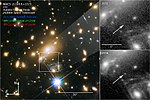|
2017 VR12
2017 VR12 is a sub-kilometer asteroid with a somewhat elongated and angular shape, approximately 160 meters (500 feet) in diameter. It is classified as near-Earth object and potentially hazardous asteroid of the Apollo or Amor group.[a] The V-type asteroid has a rotation period of approximately 1.5 hours.[5] It was first observed on 10 November 2017 by the 60-inch Pan-STARRS 1 telescope at Haleakala Observatory in Hawaii.[2][3] Orbit and classificationIt orbits the Sun at a distance of 1.0–1.7 AU once every 1 years and 7 months (585 days; semi-major axis of 1.37 AU). Its orbit has an eccentricity of 0.27 and an inclination of 9° with respect to the ecliptic.[3] 2017 VR12 is a V-type asteroid with a bright surface.[1]   2017 VR12 · Mercury · Venus · Earth · Mars 2017 VR12 passed 0.0097 AU (3.76 lunar distances) from Earth on 7 March 2018, the closest approach by this asteroid currently known. It brightened to 12th magnitude, making it one of the brightest Near Earth asteroids of the year. It was observed by radar from Goldstone, Green Bank and Arecibo Observatory. Images revealed that 2017 VR12 is a slightly elongated and angular body with a size of approximately 160 by 100 meters.[1][6][4] Physical characteristicsImages obtained at Green Bank and Arecibo observatories in 2018, revealed that 2017 VR12 is a slightly elongated and angular body with a size of approximately 160 by 100 meters.[1][6][4] On 5 March 2018, a rotational lightcurve was obtained from photometric observations by astronomers at the Northolt Branch Observatories. Lightcurve analysis gave a rotation period of 1.5 hours with a brightness amplitude between 0.4 and 0.5 magnitude (U=n.a).[5] Gallery
Notes
References
External links
Information related to 2017 VR12 |
||||||||||||||||||||||||||||||||||||||||||||||||||||||||||||

![2017 VR12, imaged at Northolt Branch Observatories on 15 February 2018. The asteroid is visible at 17th magnitude at this point, at a distance of 10.4 million km (6.5 million mi) from Earth. The image is inverted (stars appear dark, the background appears light).[7]](http://upload.wikimedia.org/wikipedia/commons/thumb/2/24/2017_VR12_NBO_2018-02-15.png/364px-2017_VR12_NBO_2018-02-15.png)
![2017 VR12 on 26 February 2018. The asteroid is visible at 15th magnitude, at a distance of 4.8 million km (3.0 million miles) from Earth. The telescope is tracking the asteroid, causing stars to trail as the asteroid slowly moves across the sky.[8]](http://upload.wikimedia.org/wikipedia/commons/thumb/a/a1/2017_VR12_NBO_2018-02-26.png/369px-2017_VR12_NBO_2018-02-26.png)
![2017 VR12 on 5 March 2018, two days before closest approach. The asteroid was 1.9 million km (1.2 million mi) from Earth at that time, visible at 13th magnitude.[9][6]](http://upload.wikimedia.org/wikipedia/commons/thumb/a/a5/2017_VR12_NBO_2018-03-05.png/316px-2017_VR12_NBO_2018-03-05.png)



